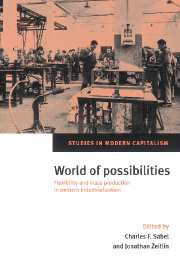Book contents
- Frontmatter
- Contents
- List of contributors
- Acknowledgments
- Stories, strategies, structures: rethinking historical alternatives to mass production
- Part I The modernity of tradition
- Part II The battle of the systems
- Part III The resurgence of flexible production
- 9 In search of flexibility: the Bologna metalworking industry, 1900–1992
- 10 Local industry and actors' strategies: from combs to plastics in Oyonnax
- 11 Producing producers: shippers, shipyards and the cooperative infrastructure of the Norwegian maritime complex since 1850
- Index
9 - In search of flexibility: the Bologna metalworking industry, 1900–1992
Published online by Cambridge University Press: 12 December 2009
- Frontmatter
- Contents
- List of contributors
- Acknowledgments
- Stories, strategies, structures: rethinking historical alternatives to mass production
- Part I The modernity of tradition
- Part II The battle of the systems
- Part III The resurgence of flexible production
- 9 In search of flexibility: the Bologna metalworking industry, 1900–1992
- 10 Local industry and actors' strategies: from combs to plastics in Oyonnax
- 11 Producing producers: shippers, shipyards and the cooperative infrastructure of the Norwegian maritime complex since 1850
- Index
Summary
This essay deals with a particular case of the flexibly specialized industrialization characteristic of the province of Bologna. The history of the engineering industry from the beginning of this century allows us to understand better the initial premises, take-off, stabilization and future potential of this development pattern. Of special interest within this history is the formation of an urban industrial subsystem, similar to Marshall's definition of an “industrial district,” in the automatic packaging machinery sector, the most successful example of flexible specialization in Bologna. Both direct influences (on the engineering industry) and indirect influences (on the overall development of industrialization) will be taken into account, and a distinction will be drawn between endogenous factors (actions produced by agents present in Bologna) and exogenous factors (actions caused, for example, by the national government or the international market).
This history can be divided into three periods: (a) 1900–1945, when the province of Bologna was predominantly agricultural and its economy precarious, even if a number of factors can be identified which explain both the later development of the engineering industry and its already visible characteristics, including those of the earliest packaging firms; (b) 1946–1980, when Bologna industrialized rapidly, with the expansion of the engineering industry and the formation of the automatic packaging machinery subsystem; (c) 1981–1992, when the effects of international competition and the transition from mechanical to electronic technology became clearly felt, the packaging subsystem entered a phase of relative stabilization, other engineering firms began a transition which could lead to the establishment of new subsystems, and previous lines of industrial development were closing down.
- Type
- Chapter
- Information
- World of PossibilitiesFlexibility and Mass Production in Western Industrialization, pp. 381 - 418Publisher: Cambridge University PressPrint publication year: 1997
- 8
- Cited by



